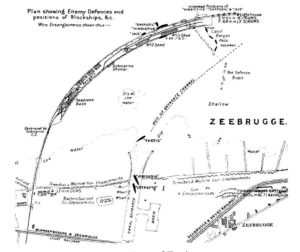- Author
- Periodical, Semaphore
- Subjects
- Biographies and personal histories, History - WW1, WWI operations
- Tags
-
- RAN Ships
- HMAS Australia I
- Publication
- September 2010 edition of the Naval Historical Review (all rights reserved)
Editor’s Note: This article first appeared in the March, 2007 issue of Semaphore, the newsletter of the Sea Power Centre of Australia. We are grateful for their ongoing permission to use their material.
On the night of 22-23 April 1918, the Royal Navy (RN) carried out an audacious raid on the German-held ports of Zeebrugge and Ostend in occupied Belgium. The purpose of the raids was to render the ports unusable as U-boat and destroyer bases. The plan was to steam three obsolete cruisers through the harbour and sink them as blockships in the Zeebrugge Canal. To do this however, also required a landing force to take over the breakwater, known as the mole, that protected the harbour and on which the Germans had mounted numerous artillery pieces and machine guns. Among the hundreds of RN and Royal Marine personnel involved in this action were a small group of Royal Australian Navy (RAN) volunteers.
In February 1918 a call went out throughout the RN for volunteers to perform a hazardous service. At this time the battle cruiser HMAS Australia was serving with the RN in the North Sea and eleven men from her ship’s company were selected from the dozens that volunteered. These men were:
- Artificer Engineer (Warrant Officer)
- W.H.V. Edgar, Leading Stoker
- W.J. Bourke, Leading Stoker
- R. Hopkins, Leading Stoker
- G.J. Lockard, Leading Stoker
- J. Strong, Stoker
- N.J. McCrory, Leading Seaman
- G.J. Bush, Leading Seaman
- D.J.O. Rudd, Able Seaman
- G.E. Staples, Able Seaman
- H.J. Gillard, and
- Able Seaman L.T. Newland.
Throughout February and March, a force of 82 officers and 1,698 men was raised and given specialist training at either Chatham or the Royal Marine Barracks at Deal. Many of the sailors were formed into 200 man ‘storming parties’ and given instruction in trench warfare, assault tactics, bomb throwing, bayonet drill, and the use of mortars and Lewis machine guns. Others were given training in demolition work.
One hundred and sixty-five vessels, including cruisers, destroyers, monitors, submarines and motor launches were involved in the raid and many of the attacking ships were specially modified in the preceding weeks. Artificer Edgar was allocated to the ferry boat HMS Iris , the five seamen to the cruiser HMS Vindictive and the five stokers to one of the three block-ships, HMS Thetis.
The Germans had heavily reinforced the Belgian coast with artillery, while in Zeebrugge, artillery emplacements ranging in size from 3.5 inch guns to 6 inch guns had been positioned within the port area. These were supported by 11 inch guns mounted further inland. All of these batteries were connected by an elaborate complex of watching, command and signalling stations.

The Zeebrugge mole was a seaward outpost of the German coastal defence system and consisted of three parts: a railway viaduct connecting the mole to the shore; the mole itself, constructed from a mass of masonry that curved to the north-east; and a narrow extension projecting from the end of the mole with a lighthouse on its extremity. All of this had been converted by the Germans into a minor fortress supporting gun emplacements and housing garrison troops. At the south-western end of the mole was a seaplane base with another garrison and concrete sheds.
Unsuitable weather conditions forced two attempts to launch the raid to be aborted but by 22 April conditions had improved. That afternoon the raiding force weighed anchor and began to assemble under thickening cloud cover. As they made their way to their target, drizzling rain began to fall but wind conditions remained favourable.
By 10.00 pm the force rendezvoused with patrolling destroyers and the superfluous men in the block-ships had been taken off by motor boats. The leading ships were now only 15 miles from the mole. At 11.10 pm the British monitors began bombarding the German coastal defences with fire being directed at Zeebrugge some twenty minutes later. At the same time coastal motor boats moved off at high speed and laid a preliminary smoke screen across the entire line of advance. Other smoke laying craft followed and soon a murky line of smoke stretched for almost eight miles running parallel to the coast.
Extraordinary seamanship
Two groups of coastal motor boats then attacked the western end of the mole to distract the enemy’s attention while Vindictive approached. Miraculously the entire expedition had reached its destination unreported and unobserved. Just before midnight the Vindictive came through the last smoke screen, moving across the narrow strip of water that separated her from the mole. She continued her approach under a hail of fire which inflicted heavy casualties on her crew and killed most of the officers in charge of her landing parties. The tidal stream was also causing problems for Vindictive as she struggled to lie alongside the mole. Fortunately the ferry Daffodil saw her predicament and in what has been described as an extraordinary piece of seamanship was able to push, and hold, Vindictive alongside. The first of the storming parties, which included five of the Australian sailors, then made their way along the narrow swaying gangways to begin their assault. A few minutes later the lris was brought alongside the mole ahead of Vindictive.




